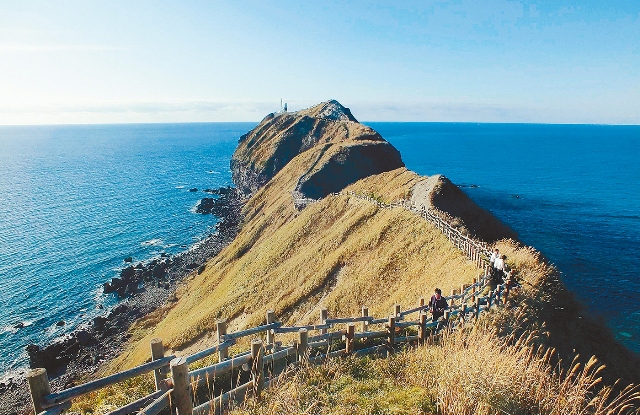

By Koichi Saijo
SHAKOTAN, Hokkaido, Japan: Kamuimisaki cape is located on the northwestern edge of the Shakotan Peninsula in Hokkaido, Japan. I walked along a narrow path that looked like a mountain ridge, going as high as 80 meters (about 262 feet) above sea level. I proceeded for about 20 minutes amid the ocean wind, and then came to the tip of the cape, which overlooks the crystal-blue Sea of Japan. This beautiful color is known as "Shakotan blue."
As the horizon appears slightly curved at both ends when observed from the tip of the cape, you can directly see that the Earth is round. Though it took about an hour from the center of Shakotan by car, the spectacle is worth the trip.
The sea offers not only this impressive view but also a variety of seafood. The town is famous for nama uni don (raw sea urchin roe topping a bowl of rice). I was there, however, just after the fishing season, which is limited to June through August.
Even so, a Japanese restaurant I visited for lunch still offered steamed sea urchin roe, and I enjoyed the kaisendon sashimi bowl decorated lavishly with northern shrimp and seasonal salmon roe. The sea urchin roe melted in my mouth, and I could taste its subtle sweetness. I felt a sense of the abundance of the sea.
Forests account for 80 percent of the town. The rains that fall on the highlands are soaked up in the mountain areas, and the nutrient-laden rivers flow into the sea. This process is believed to help the growth of seafood and seaweed.
In 2010, Japan Tobacco Inc. began a 10-year project called JT Forest Shakotan to help the conservation of these mountains. JT subsidizes the costs of forest management within the reach of three rivers running through the town, including the Bikunigawa river.
"Ill-maintained forests are recovering," said Shakotan Mayor Hideki Matsui, 68. "I want to scientifically prove that mountains foster the ocean."
Experts on forests, rivers and seas have already started investigations in their various fields.
"I hope they will collect enough data soon so that we can properly explain to children, who will be responsible for the next generation," Matsui said.
Forests not only nurture the abundant sea, but also are helping the reconstruction of areas hit by the 2011 Great East Japan Earthquake. About 2,000 trees including Japanese larches were cut down, sent to disaster-hit areas such as Miyagi Prefecture and used as foundations for temporary housing units in May 2011. The workings of nature help human beings, showing the importance of protecting nature.
The next day, I visited a traditional-style fishermen's lodge in the center of the town that was originally built for those involved in the herring fishing industry. Though its herring fishing had been the boast of the town, and there had been many houses that accommodated fishing boat owners, their families and crew members, these houses are almost all abandoned nowadays.

In 2008, residents in the town began activities to preserve these houses as sightseeing spots. Local volunteers including Noriichi Bessho, 67, renovated the lodge and named it Yamashime Banya.
A public interest corporation subsidized the costs of renovation such as for replacing the flooring.
The facility was opened to the public until late September, hosting events such as shamisen lute performances held irregularly. It is currently closed in preparation for further restoration work, but its reopening is planned for around May next year.
"I feel regret if tourists just eat sea urchin roe and leave town. I want them to know the history of Shakotan, even just a little," Bessho said.
Though the town has a population of only 2,300, many local people I met love their hometown.
Access: About 1 hour 40 minutes by plane from Haneda Airport to New Chitose Airport. Then, 1 hour 15 minutes by train from the airport to Otaru Station, and 1 hour 25 minutes by bus from the station to Bikuni, the center of Shakotan.
For more details, contact the Shakotan tourism association at (0135) 44-3715 (English inquiries accepted only on weekdays) or visit http://www.kanko-shakotan.jp
The Washington Post




